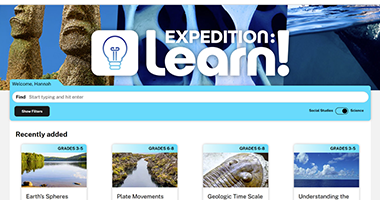Topical news stories can often be a great source of teaching material.
Britannica’s In the News presents interesting news topics at a student-appropriate level, with added context to help students develop a balanced understanding of the events, people or issues being discussed.
It’s a great way to bring breaking news into your classroom, as well as help your students stay informed in a safe and engaging way.
Here are some different tasks you can implement to make the most of Britannica’s In the News feature.
In the News! is freely accessible for all Britannica School and Britannica Library subscribers. The feature is currently not available on school.ebonline.cnpeak.com and library.ebonline.cnpeak.com.
Before Reading
These activities raise awareness of the topic, activate students’ prior knowledge and experiences, as well as develop an understanding of the language used in the article.
1. Examine the pictures used in the article. Describe and discuss what each picture portrays. Can you predict what the article is about using the pictures?
2. Look at the headline, what do you think the article is going to be about based on the headline?
3. Make a list of specialised article/topic vocabulary.
4. Discuss the intended audience and purpose of the article.
During Reading
These activities should be simple so that students develop a summary understanding of the article content. That is, what the article is about and what are the main points.
5. Review pre-reading ideas and cross check accuracy.
6. Identify the main point of the article.
7. Print the article out and cut it into sections. Have students re order the sections.
8. Asked comprehension questions such as;
- True or false
- Multiple choice
- Which paragraph tells the reader…
- What is your opinion/thoughts on…
9. Complete either the Main Idea and Details Table or Main Idea and Details Web worksheets.
10. Have students list and research key terms to find their definition.
After Reading
These activities extend students’ knowledge of the article content. They utilise the skills of talking, listening and writing.
11. Role play based on text, interview with a protagonist from the story.
12. Use the article’s key idea to develop a topic for a debate/argument.
13. Do you agree/disagree? Students prepare a list of four to five statements related to the article. Pair up and ask each other if they agree or disagree citing reasons.
14. The students write a letter to someone from the article telling them how they feel.
15. The students are in charge of planning a cover for a magazine featuring the article they just read. Examine other magazine and newspaper covers to identify key design features. Use these ideas to design the cover, including titles that will make people want to read the article.
16. Students select a section of the article that they find interesting and rewrite it, changing some of the details. Then students exchange news items with a partner and see if they can spot the lies.
Featured Image from BRITANNICA IN THE NEWS: November 15, 2022, Vinice Mabansag, who was born in the Philippines, was one of the babies named as Earth’s eight billionth person. (There’s no way to know which baby was truly the eight billionth.) Courtesy of Commission on Population and Development, National Capital Region, Philippines.
These activities and resources have been created using content from Britannica School, the go-to site for safe, comprehensive research for all ages. Find out if your school already has access or set up your own free trial.
More Educator Resources
Sign up with your email for more free resources from Britannica.

